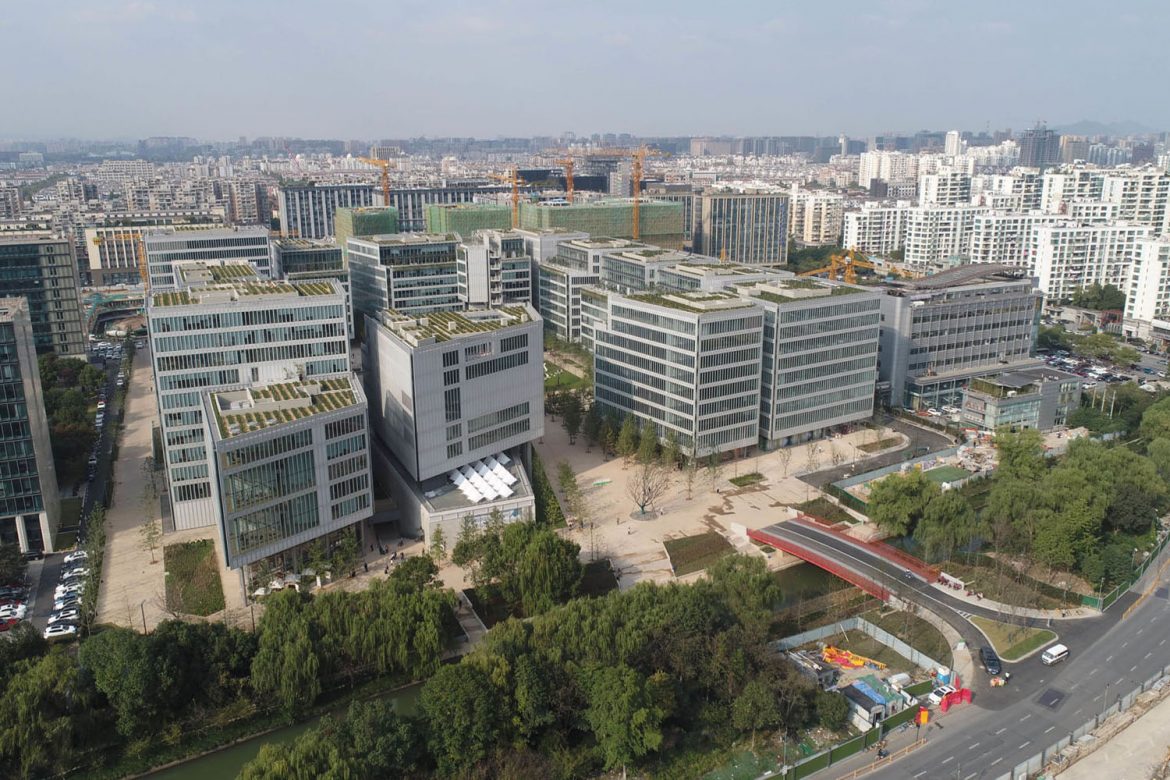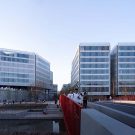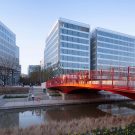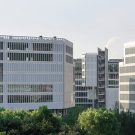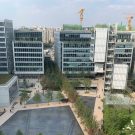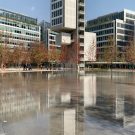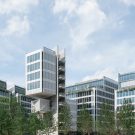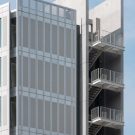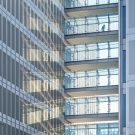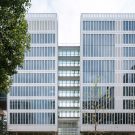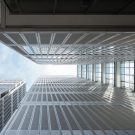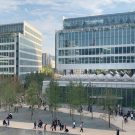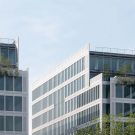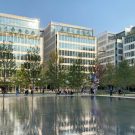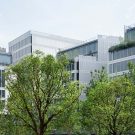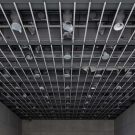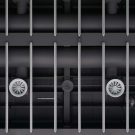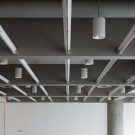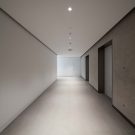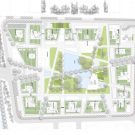Location: Hangzhou, China, Architects: Renzo Piano Building Workshop (RPBW), Group of Architects (GOA), Photographs: OōEli, RPBW, GOA, Jiali Zhou, Wen Studio
Located in Hangzhou, Zhejiang Province of China, OōEli is the first Chinese project undertaken by Renzo Piano, one of the Pulitzer Prize winners, and an iconic comprehensive art park covering an area of about 230,000 square meters and incorporating offices, art museums, art centers, show fields, design hotels, and art commerce. The project is jointly invested by JNBY, a fashion brand, and GOA. It is worth mentioning that GOA is not only one of the investors of the project, but also the executive designer of the entire park, which has provided OōEli a comprehensive and systematic technical impetus for more than seven years.
Initially inspired by an apple that has a soft and rich kernel wrapped in a hard interface, Renzo Piano finally changed the original design plan in order to introduce more air and sunlight to the square by reducing 11 floors to 9 floors and setback terraces on the 7th and 8th floors with a view ensuring sufficient sunshine in every corner. Similarly, in consideration of nature and the city, the space on the ground floor of the building lays emphasis on transparency and visual penetration. Therefore, “OōEli” is not a closed office park, but an oasis-like “city parlor” and a generator of artistic life, where a variety of activities and events will take place. Surely, people’s communication activities will also exert influence on the space, becoming the core of vitality in this park.
In terms of path setting, architects designed 8 transfer elevators in four sites around the courtyard. People must first reach the ground from the underground garage and then pass through the courtyard to enter the office building. When the glass lift car rises above the ground slowly, people are greeted by the ecological environment of the central square, which is the centerpiece of the entire park. OōEli will invite different artists to put a piece of sound art in the lift car every year, which will change according to different seasons and visitor flow rates.
Green Core. The green “core” of OōEli is a three-dimensional system, which is presented from bottom to top at different elevations: sunken courtyard, ground vegetation, reflecting pool, external flower pot on the terrace, and tea garden on the roof. The plant landscape of this park was designed by Paul Kephart, an American plant ecology expert. The green landscape extends from the underground to the ground and climbs up along the building’s facade to the roof. As the fifth facade, the roof is banked with green tea trees, a signature tree species in Hangzhou. The operation team selected two tea varieties for the tea garden – Longjing No. 43 and Anji White Tea, which have strong adaptability and can be planted in nature and cities. In order to expand the planting area on the roof, it is necessary to carefully organize the core tube and electromechanical equipment protruding from the roof, and deal with systemic technical issues such as drip irrigation, water spraying, lighting, shading, and wind prevention. OōEli has adopted a wealth of eco-friendly technologies and is applying for LEED BD+C: CS Gold Certification.
External Façade. The prefabricated unit-typed curtain wall system is extensively used for external facade except for the first floor, sunken courtyard, and terrace. The total area of the curtain wall is about 80,000 square meters, with sheet-shaped imported anodized aluminum plates as the main material. Each unit is prefabricated and assembled in the factory, then hoisted and hooked up on the construction site, which is beautiful, efficient, and environmental-friendly. Its process adopts the surface profiling treatment of sheet-shaped anodized aluminum plate, which is the first project at home that adopts this technology in a large area.
“OōEli” adopts an anodized aluminum plate produced by Christian Pohl GmbH, one of the best suppliers in the world. The same material has also been used in top-level buildings such as the World Trade Center in New York, the Jumeirah Emirates Towers Hotel, Dubai Apple Store, and Rockefeller Plaza in the United States.
Electric shading systems imported from Italy are installed on the facade of the 2nd floor facing the central courtyard and from the terrace to the roof (from the 8th to 9th floors). The 2nd floor uses an electric folding rail system and selects the unique “RPBW Green” under the guidance of the designer. The terrace adopts an electric vertical lifting rail system.
Fair-faced Concrete. The fair-faced concrete construction is one of the most important design features of “OōEli” Park. The exposed core tubes and beams of fair-faced concrete are both structural members and parts of the architectural effect to be expressed.
The fair-faced concrete construction of “OōEli” was completed by two units alternately. More than 40,000 square meters of high-quality fair-faced concrete is built by the Italian Dottor Group, whose millimeter-level construction accuracy, consistent silky texture, and the experiment of the extremely thin bearing wall of the art center have all reached the world’s top-level engineering standards, which is of great significance under domestic engineering conditions.
Currently, the commercial concrete on the market cannot satisfy the requirements of the design effect of “OōEli”, no matter in forming quality or stability. In order to ensure consistent material and stable supply, designers and engineering teams seriously selected raw materials like sand and cement. In addition, the construction site was also equipped with a mixing plant to achieve a customized supply of high-quality concrete.
Featured Architectures & Landscapes. “BY ART MATTERS”, a contemporary art gallery built with world-class construction standards, is a powerhouse for OōEli and the No. 1 gathering place for contemporary art at home and abroad. The art exhibition planning of the gallery is undertaken by Francesco Bonami, a well-known Italian curator and writer. It is worth mentioning that it applies natural light guiding system and DMX512 lighting control technology. It introduces natural light into the room by setting up lighting tubes and accessories on the roof and automatically adjusts artificial lighting according to conditions so as to save energy and improve lighting comfort.
“OōEli Space”, a rare multifunctional space in Hangzhou equipped with world-class sound and stage are equipment, can hold all kinds of exhibitions and performances such as fashion show, concert, small theater performance, forum, salon and launch event, becoming a generator of recreational activities in the park.
Structurally, both the BY ART MATTERS and OōEli Space are large-space units. Their column-free space with a maximum span of 33m at the bottom can meet the needs of a variety of exhibitions and performances, while the space with 9m in width at the top is more suitable for the office. The upper and lower structures are converted through large trusses on the 3rd and 4th floors, which also brings a smooth overall spatial experience. The large-scale fair-faced concrete wall and huge steel columns at the bottom of this building strengthen the architectural expressiveness and convey the charm of “structure as building”.
Art Residency. The art residency center located in Building 17 is named “BY ART MATTERS RESIDENCY”, which will be used as a station for artists to create and live in. The extremely thin core tube bearing wall makes this building particularly eye-catching. Its wall is 42 meters high and 18 meters long, with a thickness of only 0.3 meters. On the thin wall, the functional spaces are distributed asymmetrically on the east and west, and “floating” on the 6th to 9th floors in the west, which are suspended from the core tube by 4 steel braces, bringing a strong visual impact.
Water-mirror Square. Two huge water-mirrors in the center of the park are covered with a 2-centimeter thin layer of water. The design requires the water surface to be filled or emptied within 1 minute. The frequent rise and fall of water put forward strict requirements on the bearing capacity and flatness of the ground. And, the final effect will also be influenced by the color differences caused by the changes in the degree of dryness and wetness of the ground materials.
Sunken Courtyard. A total of 11 sunken courtyards were designed in OōEli. Among them, the three Karesansui courtyards themed “wind, water, and air” were built by the Japanese Karesansui design master Shunmyo Masuno and his team.
Bridge. Inspired by a ship, Renzo Piano designed a bridge in the location of the previous Yidi Bridge. The red bridge body is a rare red element in the whole project. The two-meter-wide sidewalks on both sides of the bridge deck make the bridge thinner and lighter.
[Text description provided by the architects]
